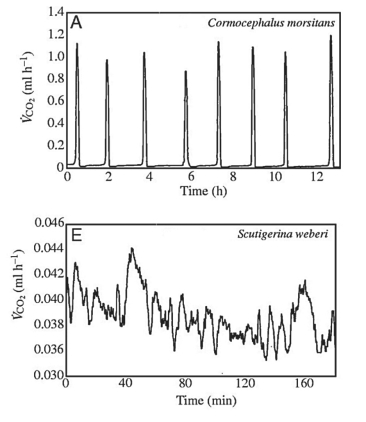Multiple Choice
Figure 33.2
Use the following information when answering the corresponding question(s) .
Many terrestrial arthropods exchange gases with their environments by using tracheae,tubes that lead from openings (called spiracles) in the animal's exoskeleton or cuticle directly to the animal's tissues.Some arthropods can control whether their spiracles are opened or closed;opening the spiracles allows the carbon dioxide produced in the tissues to travel down the tracheae and be released outside the animal.Klok et al.measured the carbon dioxide emitted over time (represented by VCO₂) by several species of centipedes.Figure 33.2 presents graphs of their results for two species,Cormocephalus morsitans and Scutigerina weberi.(C.J.Klok,R.D.Mercer,and S.L.Chown.2002.Discontinuous gas-exchange in centipedes and its convergent evolution in tracheated arthropods.Journal of Experimental Biology 205:1019-29. )

-How would a terrestrial centipede most likely benefit from the ability to close its spiracles?
A) Closing spiracles would allow the centipede to move more quickly.
B) Closing spiracles would allow the centipede to retain more moisture in its tissues.
C) Closing spiracles would allow the centipede to stay warmer.
D) Closing spiracles would allow more oxygen from the environment to reach the centipede's tissues.
E) The centipede would not benefit at all.
Correct Answer:

Verified
Correct Answer:
Verified
Q8: What would be the best anatomical feature
Q8: The presence of a lophophore in a
Q9: A _ is comprised of a mouth
Q11: Here is a statement from the text:<br>"The
Q15: You find an animal and believe it
Q16: Figure 33.2<br>Use the following information when answering
Q17: Whiteflies are common pest insects found on
Q21: The protostome developmental sequence arose just once
Q39: A cephalopod's tentacles are modified from its
Q44: Which one of these mollusk groups can